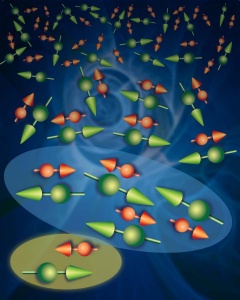Aug 21 2008
The semiconductor silicon and the ferromagnet iron are the basis for much of mankind's technology, used in everything from computers to electric motors. In this week's issue of the journal Nature (August 21st) an international group of scientists, including academic and industrial researchers from the UK, USA and Lesotho, report that they have combined these elements with a small amount of another common metal, manganese, to create a new material which is neither a magnet nor an ordinary semiconductor. The paper goes on to show how a small magnetic field can be used to switch ordinary semiconducting behaviour (such as that seen in the electronic-grade silicon which is used to make transistors) back on.
 An unconventional metal: The magnetic bar magnets (called “magnetic moments”) associated with the mobile electrons (red arrows) responsible for electrical conduction and manganese atoms (green arrows) in manganese doped iron silicide (Fe1-xMnxSi). This figure depicts the coupling of the magnetic moments as the temperature is reduced from room temperature (top of the figure) where the magnetic dipoles are independent, to very low temperature (bottom of the figure) where coupling between the dipoles creates regions where the moments add to zero (light blue region). The existence of a population of uncoupled complexes (depicted here in the yellow region) down to the lowest temperatures results in the material being neither a magnet nor common semiconductor. External magnetic fields align these rare yellow regions to the magnetic field, switching on ordinary semiconducting behaviour.
An unconventional metal: The magnetic bar magnets (called “magnetic moments”) associated with the mobile electrons (red arrows) responsible for electrical conduction and manganese atoms (green arrows) in manganese doped iron silicide (Fe1-xMnxSi). This figure depicts the coupling of the magnetic moments as the temperature is reduced from room temperature (top of the figure) where the magnetic dipoles are independent, to very low temperature (bottom of the figure) where coupling between the dipoles creates regions where the moments add to zero (light blue region). The existence of a population of uncoupled complexes (depicted here in the yellow region) down to the lowest temperatures results in the material being neither a magnet nor common semiconductor. External magnetic fields align these rare yellow regions to the magnetic field, switching on ordinary semiconducting behaviour.
The new material exists in a quantum halfway house between magnet and semiconductor - in the same way that much more complex materials such as ceramics which exhibit high temperature superconductivity exist in quantum halfway houses between metals and magnetic insulators. The research is of fundamental importance because it demonstrates, for the first time, a simple recipe for reaching this halfway house, whilst also suggesting new mechanisms for controlling electrical currents and magnetism in semiconductor devices.
Professor J.F. DiTusa of Louisiana State University and a co-author of the paper said: “It’s amazing that something which was thought to exist theoretically in mathematical physics could actually be found in an alloy which was simply formed by melting together a few common elements.”
Professor Gabriel Aeppli of UCL (University College London), another member of the research team and Director of the London Centre for Nanotechnology, added: “It might be possible to see similar effects in devices made using materials and methods found in laser pointers. This would put what we’ve seen firmly in the realm of that which can easily be achieved using current technologies.”
The first author of the paper, Dr. N. Manyala of the National University of Lesotho, said: “We are looking forward to investigating whether we can see these effects using thin layers of the same materials deposited directly on the silicon wafers. These wafers are the same as those used by mass market electronics manufacturers as the basis for integrated circuits.” Dr. Ramirez, who is now with LGS-Bell Labs Innovations echoed this thought, noting that, "with the end of Moore's law in sight, mechanisms for controlling and understanding possible new information bits such as spins in solids are actively being sought after."